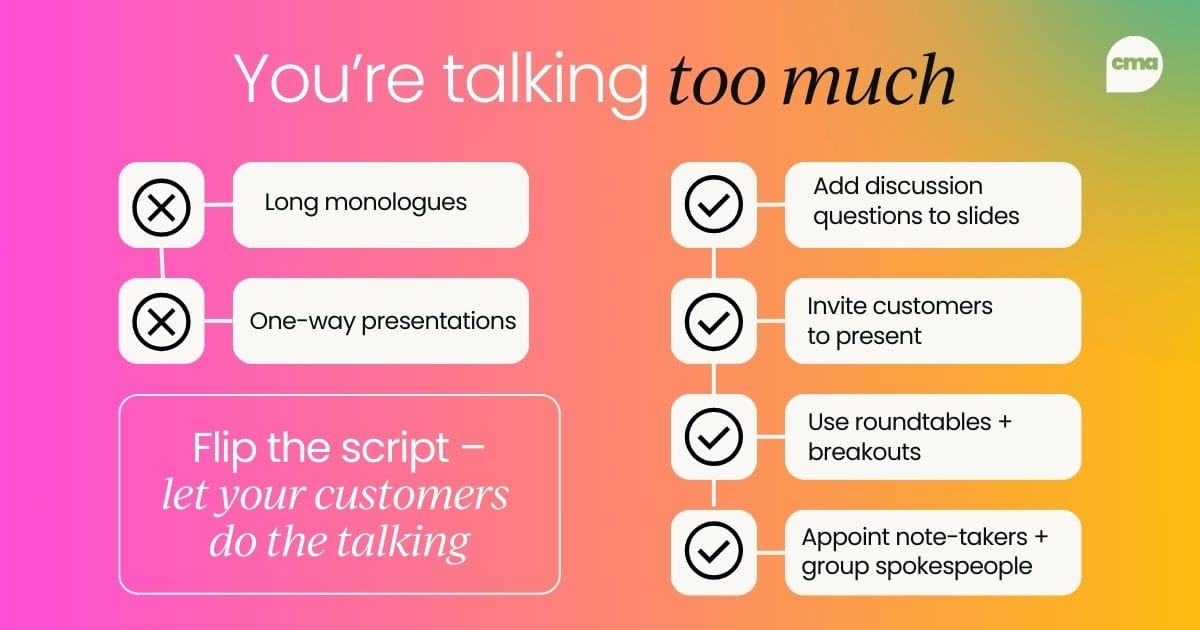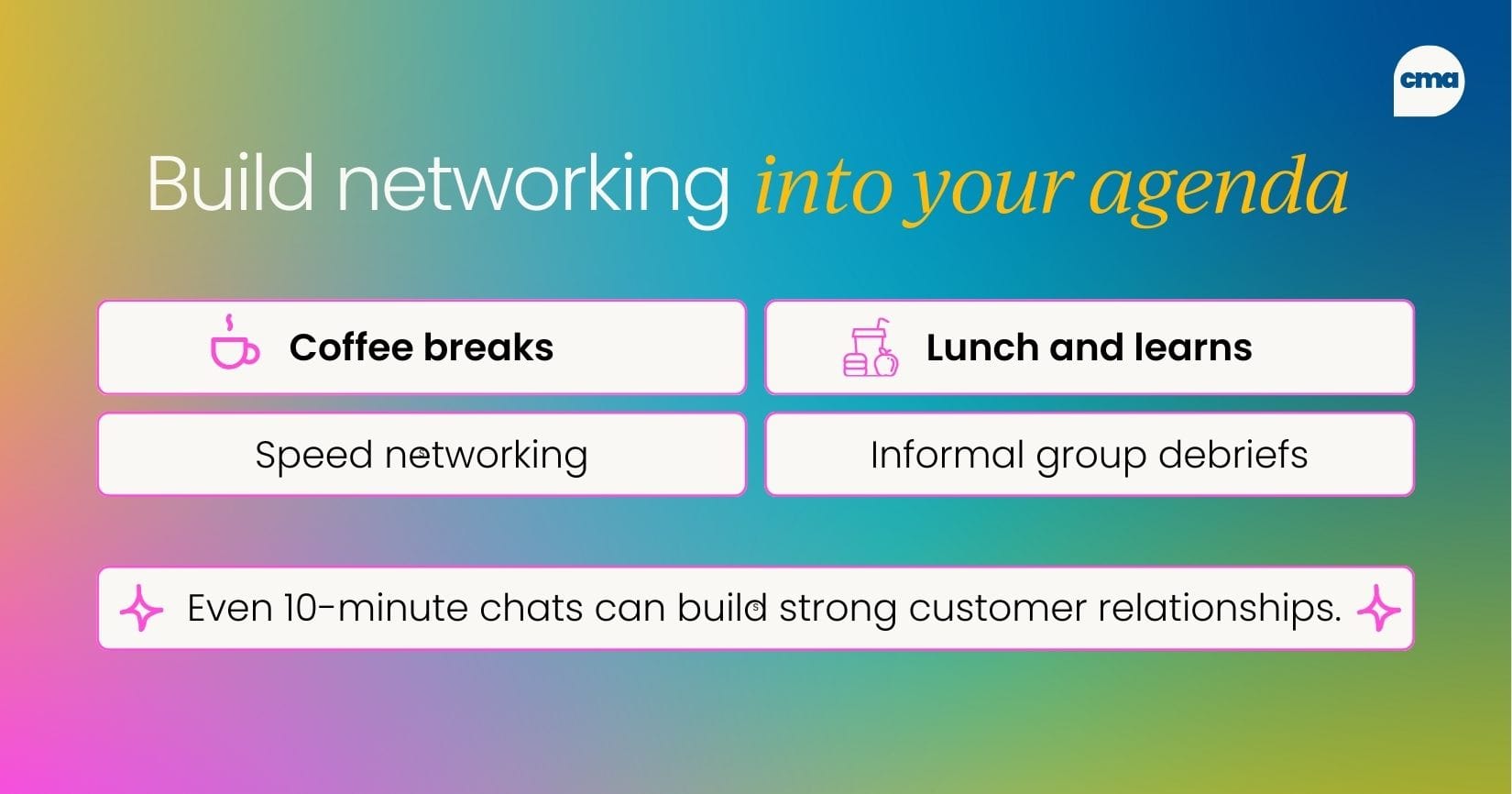Remember the feeling of sitting in a three-hour college lecture with a professor who would drone on, talking at you without any semblance of engaging the class? Chances are, your customers are experiencing that same feeling if you’re structuring your customer advisory boards (CABs) like one giant presentation. They’re BORED.
The good news is that there are five key problem areas to address that will turn your next in-person advisory board from a snooze-fest to a successful event.
Advisory boards should serve as a place where dialogue takes place. The purpose is to get in front of your customers and listen to what they have to say.
Think of this group as a sounding board. Advisory boards are the opportunity to gut check strategy, messaging, and the direction you are taking as a company.
And no, I don’t mean spilling trade secrets–or maybe, if that’s where you are at with this group.
The goal is to have an open and honest discussion backed by a solid agenda. This keeps the meeting structured enough for both parties to derive value from the meeting, but allows for the flexibility to explore what’s top of mind for your customers.
Let’s get into it, shall we?
1. Not enough dialogue
Your number one problem is that your team is the one doing the talking; not good. But you have a major opportunity here to flip the script and get your customers talking.

The natural inclination is to see all this face time with your customers as a chance to tell them all about the amazing things you’re doing as a company. I get it. It’s tempting. I’ve been there too.
The thing with that is you bias the conversation from the beginning; you’ll continue to drive discussion around what you are already discussing internally.
So what’s the workaround?
Let your customers speak
And when you are “presenting,” bake in discussion questions. After each main point, turn it over to your audience. For example, if you want to kick off the day with a macro-level discussion on industry trends, consider asking:
- “Are these trends consistent with what you are seeing in your market?”
- “What opportunities are you seeing as a result of this industry shift?”
- “How are you adapting to this change?”
- “How can we set you up for success during this time?”
Next, get your customers to present as well; flip the script and have your customers speak to recent wins, strategies for success, or challenges they are having, and workshop them as a group.
Make presentations more interactive
Another engaging way to deviate from a classic presentation is to turn a hot topic into a group discussion. Better yet, split the group up and discuss a given topic in smaller roundtables. Be sure to balance the number of internals and customers per group. You may also consider being strategic about which customers you pair up beforehand, and split breakout groups up this way.
Lastly, assign one note-taker and one spokesperson per group. At the end of the segment, reconvene as a larger group and have each spokesperson share the learnings with the broader group.
As you plan your next advisory board, be thoughtful about how you can invite more discussion into your agenda. Try and limit the amount of time you are presenting. The goal isn’t to eliminate presentations altogether, rather, it’s to over-index on the amount of time your customers get to be the ones sharing. A big part of fostering those discussions is facilitating customer connections.
Cue the networking.
2. You’re missing networking opportunities
Another huge problem in CABs is that networking is an afterthought. The way around this? Craft your agenda with networking in mind.

Bake connection time into your agenda
When putting together your advisory board agenda, think through where you can inject opportunities for your customers and your team to engage with each other outside of the structured meeting time.
The networking opportunities don’t have to be a formal cocktail hour either. Simply looking at your breaks and meal times for those opportunities is more than enough. Get the group out of their seats; give them an opportunity to stretch their legs, grab a snack, some much-deserved coffee, and take a break.
These “networking opportunities” are the proverbial water-cooler moments of the day. It’s the chance for customers to:
- Catch up if they've met before
- Make new industry acquaintances
- Strengthen their relationship with your team
Monetizing through networking
If you’re looking to monetize your advisory board, these networking moments are a great time to invite sponsors or partners. It allows them time to socialize with your most strategic accounts, without being privy to the confidential discussions being had during the meeting.
Encouraging participation
If you want the dynamic of your customer advisory board to be one where attendees feel comfortable sharing, there needs to be some baseline level of familiarity with one another. The round robin intro is a good start, but the more informal the time to engage, the better.
In a previous role, I revamped our advisory board structure, dedicating the first hour of the day to speed-networking. Every 10 minutes, my team rotated our attendees through different stations to engage with fellow advisory board members and our team.
At each table, there was a list of discussion topics. This allowed everyone to start their day socializing and moving around, while getting to know one another. This primed the group to share more openly as our team began our discussions for the day.
One big consideration when thinking through the general atmosphere of your advisory board is who is in the room.
3. You’ve got the wrong people in the room
This leads us to problem number three: what happens when your CAB casting isn’t quite right?
One solution is to prioritize membership discussions during the planning stage. While the agenda is a super important part of planning your advisory board, I would make the case that it’s who you invite that is even more important.

Be strategic with your invitations
My advice is to be very strategic about who’s in the room and whether they’re the right fit. The criteria for invitation should be directly tied to your advisory board’s goals. Consider how much they have been exposed to your product, their seniority, expertise, and industry.
If you’re looking to have discussions tied to your long-term vision and strategy, consider inviting customers who have a stake in that long-term vision. They may not be direct users of your product, but instead could be functional leaders or executive sponsors of the program that included the implementation of your product in the first place.
In contrast, if you are centering the majority of your advisory board discussions around product or operations, you may consider inviting direct users so you can really get into the weeds.
Be sure to consider the features or programs that are closely tied to your organization’s overall strategy, and invite avid users in those areas. They’ll have direct experience to speak to and the most user-centric feedback, which will most likely be an accurate representation of your customer base.
Aside from the level of involvement with your product, you should also consider their personality. Ideally, you want someone who is engaged, participatory, willing to share, who will provide meaningful feedback, and who will contribute to the discussions as much as they will listen to others.
Watch out for competitors and personalities
Be sensitive to inviting direct competitors to the meeting. In some cases, there is no way around it. Simply be mindful of how much a customer can share, and don’t press them if there are areas they are less willing to speak about.
Balance between internal and external attendees
These discussions are super interesting, and you may get a lot of interest from team members who want to attend. However, it is not realistic to have everyone there. Do what is best for achieving the outcome you want. You can always share the findings with a broader group once the session has concluded and you move on to the action planning phase.
4. The sessions aren’t delivering value
If you receive feedback from your customers that the sessions aren’t worth their time, there’s only one thing to learn: you need to be better at setting clear expectations.

Set expectations clearly
If your customers are in attendance, recognize they’re taking time away from their organization, team, and family to be with you. As such, the value they are getting from attending needs to be clearly communicated and lived up to. They need to clearly be able to answer their “What’s in it for me?”
Outline how you expect them to participate, highlight key discussion areas so they know what they are walking into, and consider getting a pulse for the topics that are top of mind for them.
A simple way to do this is by including a question upon registration that gives them a chance to tell you what they want to talk about. Take that and work it into your agenda. You may also use these as topics to seed the discussion.
Make the experience feel premium
During an advisory board meeting in a previous role, our events team helped level up the experience for attendees with two key components:
- The venue itself was a beautiful golf course with stunning views. The location was a subtle way of saying “thank you” to our customers for finding the time to be with us.
- The post-meeting dinner included a sommelier experience whereby the menu included a wine pairing and explanation at each course. This premium offering was yet another way to show our appreciation to our guests.
Ideally, you're engaging with strategic accounts at advisory boards. As such, think about the session not as one giant meeting, but as an experience you are inviting them to.
Tailor the experience to your industry. If you are organizing any activities in the days before/after the event, be sure it is something your customers would actually enjoy or can learn from.
Show gratitude in meaningful ways
Another way to tailor the experience is by showing gratitude. A nice touch is a “thank-you” gift. Things like goodie bags with items your target persona will actually use go a long way.
If, for example, your customers are sales leaders who travel a lot, you may consider travel-related items. You’ll stay top of mind each time they reach for their new favourite piece of branded merch, long after your event has concluded.
Now that we’ve gone through a few areas directly tied to your customers, it’s time to look inward. You may not have the most successful advisory board program due to a lack of internal alignment.
5. Lack of internal buy-in
Still struggling to engage your CAB meetings? Then there may be a final problem lurking beneath the surface: Your team is not seeing the value, and your customers can sense it.
To avoid this, your team needs to understand the vision so you can show up as a unified front.

Build internal support around a shared vision
So many teams make this mistake and forget you need to consider your internal customers, too. They’re equally as important in making your advisory board a success.
If you’re about to embark on an advisory board strategy overhaul, make it crystal clear what you are trying to achieve, what is required of your internal stakeholders, and why you are making these changes.
I like to anchor to the “why” behind CABs. It’ll look different from company to company, but here are my top three:
- Align with strategic customers
- Co-develop solutions
- Build community
I encourage you to partner with your leadership team. Understand what kinds of insights they are looking to glean from customers. Make sure they feel heard and keep their interests in mind as you design your next meeting.

Elevate customer insights into action
Where possible, dedicate time in your agenda to highlight positive changes their teams have implemented recently. You can start by bringing awareness to the desired impact of new programs or features. Then, transition the segment to sourcing feedback on how customers have received these new changes.
A helpful method is using the “start-stop-continue” framework. Crowdsource customers’ thoughts around things they want to see implemented, things they secretly wish you would sunset, and areas they are perfectly content with that don’t need changing.
When thinking through internal buy-in, it’s critical that you present your CAB program as an invaluable way to represent the voice of the customer. The insights you capture should spark internal discussions around what’s next. It’s not to say that you need to action every single piece of feedback.
However, it does offer your team the chance to look at current priorities and get a sense for where energy can be better focused to optimize your customers’ experience.
Final thoughts and next steps
As the owner of a customer advisory board program, challenge yourself to see things from your customers’ perspective. Think through what would be most engaging for them, while also making it worth your team’s time.
The above examples are problem areas with solutions that are relatively low-medium lift that can be game-changers when looking to maximize impact.
Start by making a few changes. Collect feedback via a post-event survey from both internal and external attendees. Discover what worked, and even more importantly, what didn’t.
In the spirit of inviting your customers behind the scenes, be transparent about the changes you are making, and don’t be afraid to try something new. Good luck planning your next customer advisory board, you’ve got this!


 10 min read
10 min read
 Follow us on LinkedIn
Follow us on LinkedIn



